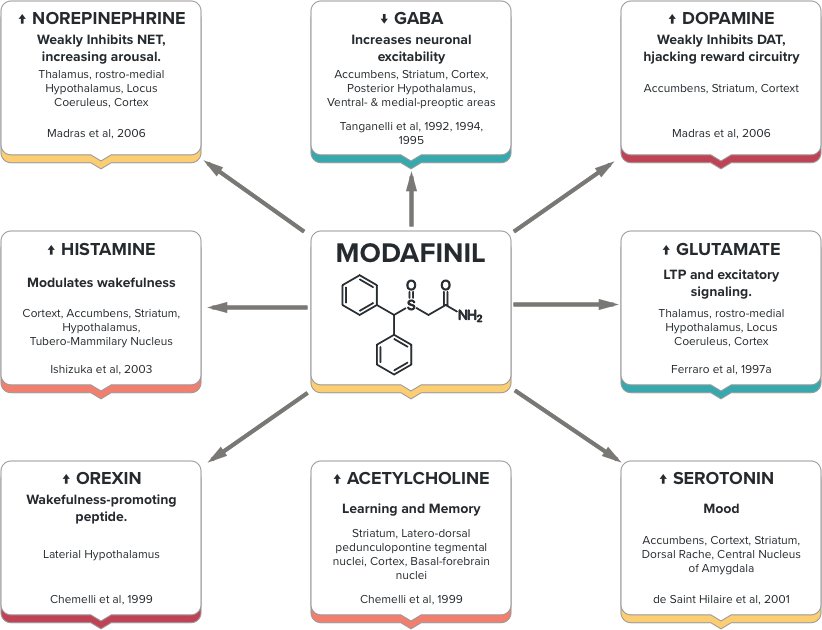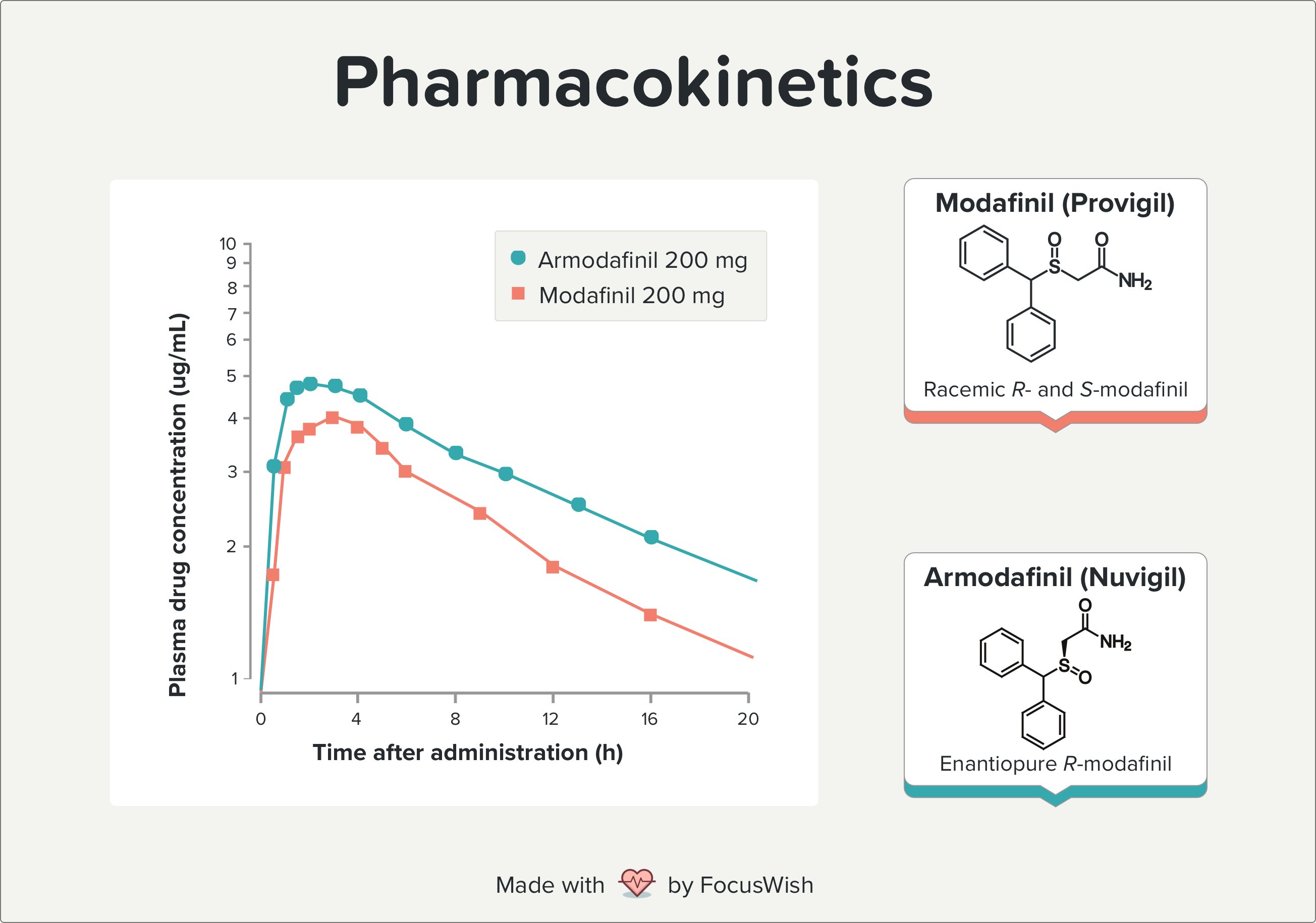Must Reads
- Modafinil Enhances Attention and Alerting Performance in Healthy Volunteers
- Where To Get Modafinil Online - Vendor Comparison Chart
- 5 Tips For Beating Modafinil-Induced Anxiety
- 5 Ways To Combat Modafinil Tolerance
- 🔥AfinilExpress Review🔥 If You Read One Article About AfinilExpress, Read This One
- Where To Buy Modafinil Online in 2019
The fact that you develop modafinil tolerance is a Good ThingTM.
It means that your brain can adapt. Your brain is always trying to maintain homeostasis. When a drug is introduced into your body, your brain adjusts its neurochemical milieu in an effort to return to its baseline state.
In this post, I will discuss a few techniques I've used to reduce modafinil tolerance. But first, we'll start with the basics.
What Is Tolerance?
In pharmacology, tolerance is the observation that the efficacy of drugs diminish over time and with habitual use. Tolerance sometimes leads to dose escalation. Tolerance is usually only problematic if the drug is addictive (e.g., opioids).
Tolerance to pain medication is a serious problem.
Imagine being a chronic pain patient who can't function without pain relief. If you're taking opioids, chances are you'll develop tolerance to the analgesic (pain-relieving) effects. This means that the efficacy of the drug will degrade over time.
Your physician can prescribe you a higher dose of pain medication, but then the higher dose will also gradually lose effectiveness.
One workaround is to take breaks from a drug, or cycle drugs that have similar effects but different mechanisms.
Summary
- Tolerance is reversible
- The rate of tolerance development depends on dose, frequency of use, and the drug (e.g., tolerance develops rapidly for phenylpiracetam)
Types of Tolerance
- Pharmacodynamic tolerance. The response to a molecule at the cellular level is reduced with repeated use. Incessant receptor occupancy leads to pharmacodynamic tolerance.
- Pharmacokinetic tolerance. This occurs when the fraction of a drug reaching its targets is reduced. E.g., enzymes which degrade the substance may be induced by it, increasing clearance.
- Behavioral tolerance. This refers to tolerance to the behavioral effects of a drug. For example, modafinil might initially increase locomotor activity but this effect may diminish over time. Behavioral tolerance can be caused by pharmacodynamic tolerance or learned behaviors that combat the effects of the drug.
What is Cross-Tolerance?
Cross tolerance may be described as follows:
Two drug are "cross-tolerant" if the development of tolerance to one drug is also likely to carry over to a second drug.
Let's say you become tolerant to the effects of modafinil. If modafinil was cross-tolerant with Adderall, what would that mean?
It would mean that even if you've never taken Adderall, your tolerance to modafinil would "carry over" if you switched to Adderall. Note that Adderall and modafinil are not subject to cross-tolerance - this was just for illustrative purposes.
When two drugs share a mechanism or belong to the same class they are much more likely to produce cross-tolerance. For example, tolerance to one opioid will result in the development of tolerance to most other opioids.
Shared mechanism of action is the key characteristic because pharmacodynamic tolerance occurs at the level of receptors.
If a ligand (drug, molecule, etc) binds to a receptor repeatedly, the receptor may become modified (e.g., phosphorylated) at a specific site that reduces the sensitivity of the receptor to the ligand.
Getting A Handle On Modafinil Tolerance
You're much less likely to become tolerant to modafinil than you are to other medications like Adderall or Xanax.
That's because modafinil's mechanism is complex and heterogeneous. Modafinil hits a smorgasbord of neurotransmitter systems, including:
- GABA
- Glutamate
- Histamine
- Orexin
- Gap junctions
- Dopamine
...and so forth.

Modafinil's lack of a "unitary" mechanism or single neuronal target means that it's harder for your brain to build tolerance to its effects.
Technique #1 Magnesium
Magnesium is well-known to reset tolerance to drugs. Magnesium is an essential dietary mineral that plays an important role in the brain.
Magnesium sits in the pore of NMDA receptors and helps prevent hyper-excitability. These NMDA-type glutamate receptors play a role in addiction, tolerance, and withdrawal.
Modafinil's mechanism of action remains elusive, but the drug definitely affects glutamate and NMDA receptors (indirectly).
Supplementing magnesium is a good way to help reset tolerance to modafinil. There are lots of magnesium formulations on the market, but it doesn't particularly matter which you choose provided that it's good quality. I usually take magnesium l-threonate, but this can be harder to find.
Another perk of magnisium is that it's a nootropic in its own right.
Also consider:
- Glycine
- D-cycloserine
Cycling Modafinil
The absolute best way to reduce modafinil tolerance is to take breaks from the drug.
Just like tolerance to modafinil develops gradually over time with chronic use, tolerance also dissipates the longer you're modafinil-free.
Phenylpiracetam has similar (albeit weaker) effects to modafinil. Sometimes I will cycle phenylpiracetam and modafinil, taking these nootropics on alternating days.
Switching to Armodafinil
Anecdotally, I've heard that switching to armodafinil can help reduce modafinil tolerance. However, I can't fathom by what mechanism this would work since armodafinil is already present in modafinil.

One explanation is that since armodafinil is more potent (mg for mg) than modafinil switching convinces people that they've reduced their tolerance. But in fact they're just taking the more potent version of the drug.
Modafinil and Enzymatic Induction
Recall our discussion of pharmacokinetic tolerance?
Modafinil is subject to pharmacokinetic tolerance because it is an inducer of CYP3A4 enzymes.
CYP3A4
CYP3A4 is a hepatic (liver) enzyme that helps metabolize and clear drugs - including modafinil - from your system. Modafinil induces this enzyme. This means that the act of orally ingesting modafinil will cause your body to respond by producing more CYP3A4 in your liver. In turn, this hastens the clearance of modafinil because more CYP3A4 is available to remove it.
Interestingly, modafinil can interact with other drugs that metabolize CYP3A4:
Coadministration with modafinil alongside opioids such as hydrocodone, oxycodone, and fentanyl, as well as various other drugs, may experience a drop in plasma concentrations. The reasoning behind this action is because modafinil is an inducer of the CYP3A4 enzymes. If not monitored closely, reduced efficacy or withdrawal symptoms can occur.[medical citation needed]
Grapefruit

In the late 90's, researchers demonstrated that grapefruit is a powerful inhibitor of CYP3A4.
This means that grapefruit ingestion can impact the pharmacokinetics of modafinil.
Since modafinil is an inducer of CYP3A4, ingesting grapefruit could theoretically offset this effect and suppress CYP3A4 activity.
Beware the Honeymoon Phase
What's the honeymoon phase of a drug?
This is the period of time when you start a new drug and its effects seem very powerful. This is due to many factors:
- The placebo effect. You expect to feel certain effects.
- Zero tolerance. When you first start a medication you won't be tolerant to its effects.
- Drug naiveté. If you are naive to drugs, you're more likely to experience a honeymoon phase.
Don't confuse the honeymoon phase with tolerance. When you first start a drug, it can feel like magic bullet because your expectations to feel better are at an apogee.
But the "loss of magic" you might experience with modafinil doesn't necessarily mean you've become tolerant to its effect. It might also simply indicate that you've lost some of the psychological boost associated with taking a drug that you believe will improve your productivity or performance. Never underestimate the placebo effect!
